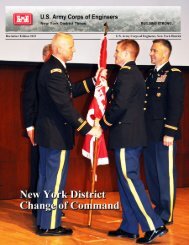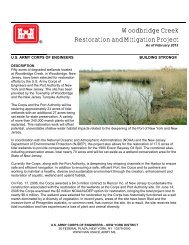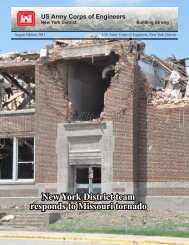The New York District Times - U.S. Army
The New York District Times - U.S. Army
The New York District Times - U.S. Army
Create successful ePaper yourself
Turn your PDF publications into a flip-book with our unique Google optimized e-Paper software.
<strong>The</strong> <strong>New</strong> <strong>York</strong><br />
<strong>District</strong> <strong>Times</strong><br />
is a publication of the<br />
U.S. <strong>Army</strong> Corps of Engineers<br />
<strong>New</strong> <strong>York</strong> <strong>District</strong><br />
Inside this issue<br />
Colonel’s Corner Page 3<br />
Science Center helps cadets reach Page 4<br />
for the stars<br />
Winning the enery savings battle in NJ Page 6<br />
Inspiring the next generation Page 8<br />
Around the <strong>District</strong> Page 9<br />
Warrior in Transition Complex Page 11<br />
A Vision of a World Class Harbor Estuary Page 12<br />
Commander and<br />
<strong>District</strong> Engineer<br />
Col. John R. Boulé II<br />
Chief, Public Affairs<br />
Kenneth Wells<br />
Kenneth.Wells@usace.army.mil<br />
Editing and Design<br />
Mary C. Stavina<br />
Mary C Stavina@usace.army.mil<br />
Graphics and Images<br />
Daniel Desmet<br />
Daniel.Desmet@usace.army.mil<br />
On the Cover...<br />
West Point Science Center,<br />
Bartlett Hall, constructed in<br />
1913, along with the academy’s<br />
old library has been renovated<br />
and combined to create one<br />
large science center. It will take<br />
science education far into the<br />
21st century.<br />
See page 4<br />
Federal Employees <strong>New</strong>s in Brief Page 14<br />
<strong>District</strong>’s People Page 15<br />
Col Boulé - A Look Back Page 16<br />
<strong>District</strong> Regulator Says Farewell Page 17<br />
Best of the Best Urban Beaches Page 18<br />
Picnic Collage Page 19<br />
Authorization: <strong>The</strong> <strong>New</strong> <strong>York</strong> <strong>District</strong> <strong>Times</strong> is an authorized<br />
unofficial newsletter of the <strong>New</strong> <strong>York</strong> <strong>District</strong>. It is published in<br />
accordance with <strong>Army</strong> Regulation 360-1.<br />
Circulation: 1500 copies per issue in print and available on internet<br />
at: www.nan.usace.army.mil<br />
Contents: Views and opinions expressed herein<br />
are not necessarily those of the Department of the<br />
<strong>Army</strong> or this command. All photos, unless otherwise<br />
credited, are official U.S. <strong>Army</strong> photos.<br />
Submissions: <strong>The</strong> Public Affairs Office welcomes<br />
comments and opinions about the information<br />
published in the <strong>New</strong> <strong>York</strong> <strong>District</strong> <strong>Times</strong>. <strong>New</strong>s,<br />
tips, ideas, suggestions and articles may be sent<br />
to: kenneth.wells@usace.army.mil<br />
<strong>New</strong> <strong>York</strong> <strong>District</strong> Building Strong Page 2<br />
®
Colonel’s Corner<br />
Our programs will change, but taking care of people will continue<br />
to be key to our success<br />
Teammates,<br />
It’s no secret that the Corps of Engineers, including us here at the <strong>New</strong><br />
<strong>York</strong> <strong>District</strong>, could be in for some lean times in the coming years. With talk<br />
of reining in federal spending as well as the completion of large missions<br />
like BRAC, the President’s stimulus and the Harbor Deepening we will need<br />
to take a strategic approach to manpower issues as we move forward.<br />
While these challenges will not be simple ones to overcome, I’m confident<br />
that the <strong>New</strong> <strong>York</strong> <strong>District</strong> team can manage them. In order to better<br />
Col. John R. Boulé II<br />
Commander<br />
manage these sort of budget and workload fluctuations, <strong>District</strong> leadership has been working with the Workforce<br />
Assessment Committee and Human Resources on forecasting and assessing workload and manpower<br />
figures in an attempt to find a solid balance between the two for the present as well as in the future.<br />
<strong>The</strong> goal of this Workforce Assessment Team is to help ensure the <strong>District</strong> stays healthy through the years,<br />
whether in lean times or flush times so we are positioned for success if large-scale missions or programs come<br />
our way as they did with the President’s stimulus and BRAC 2005.<br />
Two main parts of ensuring a healthy future are taking advantage of and expanding opportunities to serve the<br />
public and our partners and, most importantly, taking care of our workforce.<br />
Exploring additional opportunities to contribute as other agencies downsize is critical to the <strong>District</strong>’s future<br />
and will help us to take care of our personnel in the long run.<br />
This means exploring more prospects for work across all our technical functions in the Interagency and International<br />
Support program, which in FY12 included about $13 million in work and in FY13 is projected to have<br />
approximately $81 million in work.<br />
We are already working closely with partners like the Port Authority of <strong>New</strong> <strong>York</strong> and <strong>New</strong> Jersey, the Environmental<br />
Protection Agency and <strong>New</strong> <strong>York</strong> City on projects and have shown them the value and expertise the<br />
Corps brings to the table. As we continue to engage them, we need to make it clear that we’re able to support<br />
more of their programs to help them achieve their goals.<br />
We also need to look at the possibility of providing more reachback support to forces overseas in places like<br />
Afghanistan where the <strong>District</strong> has already awarded contracts for more than $45 million in work this calendar<br />
year.<br />
By diversifying and expanding the <strong>District</strong>’s portfolio, we’re creating opportunities for employees already<br />
here to further develop their skill sets and be challenged while contributing to the mission.<br />
Expanding the <strong>District</strong>’s portfolio isn’t a silver bullet though and the possibility of workload reductions is a<br />
real one. That’s why the <strong>District</strong>’s Human Resources team is aggressively working to manage workforce balance<br />
issues as they arise without having to resort to drastic force reduction measures.<br />
Cont’d Page 18<br />
<strong>New</strong> <strong>York</strong> <strong>District</strong> Building Strong Page 3<br />
®
By JoAnne Castagna, Public Affairs<br />
In the late 1960’s young Shane gazed at his TV screen in<br />
awe as he watched astronauts walking on the Moon. It was<br />
at that time that he set his sights on becoming one of them.<br />
Today Col. Robert “Shane” Kimbrough, a National Aeronautics<br />
and Space Administration (NASA) astronaut and<br />
active duty <strong>Army</strong> Colonel, looks back and believes that the<br />
science education he received at the U.S. Military Academy<br />
at West Point, <strong>New</strong> <strong>York</strong> helped him to reach his dreams.<br />
<strong>The</strong> academy’s science education is about to get even<br />
better. <strong>The</strong> U.S. <strong>Army</strong> Corps of Engineers, <strong>New</strong> <strong>York</strong><br />
<strong>District</strong> is constructing a new science center for the cadets<br />
at the academy that is maintaining the look of the historic<br />
200-year old campus and taking their science education<br />
well into the 21st Century.<br />
<strong>The</strong> academy is<br />
known as one of the<br />
world’s preeminent<br />
leader development<br />
institutions and has<br />
graduated a number of<br />
famous individuals including<br />
two presidents<br />
of the United States,<br />
numerous famous<br />
generals, seventy-four<br />
Medal of Honor recipients<br />
and many successful<br />
NASA astronauts,<br />
like Kimbrough<br />
who graduated from<br />
West Point in 1989.<br />
“<strong>The</strong> science<br />
education I received<br />
piqued my interest and<br />
made me want to do<br />
things I normally didn’t think of doing. It also was a huge<br />
foundation for me becoming an astronaut.<br />
and experimentation techniques all of which are invaluable<br />
skills I need as an army officer and NASA astronaut”<br />
said Kimbrough who has flown on the Shuttle and performed<br />
several spacewalks.<br />
Kimbrough is excited about the new science center<br />
being constructed by the <strong>Army</strong> Corps and says the cadets<br />
will be even more prepared for what the future brings.<br />
<strong>The</strong> <strong>Army</strong> Corps’ <strong>New</strong> <strong>York</strong> <strong>District</strong> has performed a<br />
number of construction projects for the academy over the<br />
years and was asked to construct a new science center as<br />
their old science building and equipment were getting<br />
outdated and they want to stay competitive with other<br />
educational institutions of the same caliber.<br />
<strong>The</strong> <strong>Army</strong> Corps is constructing the new science center<br />
by renovating and combining two existing buildings, the<br />
academy’s old science building Bartlett Hall that was<br />
originally constructed in 1913 and the academy’s nearby<br />
old library.<br />
<strong>The</strong> academy provided me an incredible physics, chemistry<br />
and biology education and skills in problem solving<br />
<strong>New</strong> <strong>York</strong> <strong>District</strong> Building Strong Page 4<br />
®
Since the campus is a national historic landmark and<br />
home to many historic sites, buildings and monuments, the<br />
<strong>Army</strong> Corps was asked to perform the work by keeping the<br />
gray and black granite shells of both neogothic buildings<br />
intact.<br />
<strong>The</strong> Corps is doing this by gutting and renovating the<br />
interiors of both buildings and connected them to create<br />
one large science center.<br />
<strong>The</strong> new science center when completed will be an expanded<br />
and modernized multi-purpose science facility that<br />
will sit on 300,000 square feet of property. <strong>The</strong> complex<br />
will have larger classrooms and labs and new equipment for<br />
the cadets to study physics, optics, laser technology, chemistry,<br />
life sciences, biology and biochemistry.<br />
<strong>The</strong> <strong>Army</strong> Corps is working in collaboration with the<br />
academy to make renovations that will improve the science<br />
education for the cadets and accommodate the needs of the<br />
faculty.<br />
<strong>The</strong>se improvements include constructing larger labs<br />
with more state-of-the–art equipment to accommodate the<br />
4,400 cadets that are all required to take chemistry and<br />
physics.<br />
At West Point we encourage the cadets to perform hands<br />
on science experiments and this building’s new design is<br />
helping us expand on this. <strong>The</strong> <strong>Army</strong> Corps is taking this<br />
opportunity to re-think how the science needs to be taught,”<br />
said Col. John Graham, Associate Dean for Research and<br />
Chief Scientist, U.S. Military Academy at West Point.<br />
“Instead of having five or ten cadets doing the same experiment,<br />
two are now doing it. This is amazing. Whenever you<br />
do science in a large group, obviously someone always gets<br />
left behind in the group, but when there are two they both<br />
can play an active role in the work. We are revolutionizing<br />
how we do science here.”<br />
Graham who is a West Point graduate added, “We used to<br />
have limitations on what scientific experiments are cadets<br />
could do because it wasn’t safe. Now they can do them.<br />
Our faculty is very excited.”<br />
For example, piping was placed strategically so that the cadets<br />
can move fluids around during chemistry experiments<br />
and outlets were located to better facilitate the use of the<br />
computers in the labs.”<br />
<strong>The</strong> cadets are already benefiting by the <strong>Army</strong> Corps’<br />
work. <strong>The</strong>y are performing the renovating in one area<br />
of the construction site while classes are safely taking<br />
place in another area of the site. This allows the cadets<br />
to get their courses completed without any delay due to<br />
the construction.<br />
<strong>The</strong> <strong>Army</strong> Corps may be modernizing the academy’s<br />
science education, but they are maintaining the<br />
historic look and feel of the campus. <strong>The</strong>y are doing<br />
this by preserving the building’s granite exteriors with<br />
their old glazed leaded glass paned windows.<br />
<strong>The</strong>y are also preserving other historic elements<br />
of the buildings including some of the interior stone<br />
walls, marble, slate and wrought iron railings and tile<br />
flooring. As well as a staircase and ceiling arch ways.<br />
“<strong>The</strong> goal for historic integrity is not to try to copy<br />
or mimic. It’s to try to blend in and replicate and make<br />
it look new but still take on some of the details of the<br />
old architecture,” said Jeffery Friese, senior project<br />
engineer, U.S. <strong>Army</strong> Corps of Engineers, <strong>New</strong> <strong>York</strong><br />
<strong>District</strong>.<br />
Doing this is not easy said Friese, “It’s very challenging<br />
to just gut the interior and leave the exterior.<br />
This is especially so when you have limited access to<br />
the building because there is limited space around the<br />
building, limited areas to get in and out of the building<br />
and when there is an occupied building next door. This<br />
is a very congested area of the post.”<br />
Another challenge for the engineers is the wiring.<br />
“When you turn a library into a science building there<br />
is just no ceiling space for all of the wiring,” said<br />
Timothy Cain, Contracting Office Representative, U.S.<br />
<strong>Army</strong> Corps of Engineers, <strong>New</strong> <strong>York</strong> <strong>District</strong>.<br />
“It’s a challenge to coordinate and organize all of<br />
the wiring, science lab items, utilities and plumbing in<br />
the ceiling. It was a massive coordination effort to get<br />
everything to fit and everything to layout the way we<br />
liked it, “ said Cain..<br />
<strong>The</strong> building may appear untouched from the outside,<br />
but the <strong>Army</strong> Corps is modernizing the center to<br />
make it a safer environment for the cadets and faculty.<br />
Cont’d page 10<br />
<strong>New</strong> <strong>York</strong> <strong>District</strong><br />
Building Strong ®<br />
Page 5
By JoAnne Castagna, Public Affairs<br />
In 2004, Master Sgt. Mark Rizzo’s U.S. <strong>Army</strong> convoy<br />
was traveling north on a route in Baghdad, Iraq.<br />
“I was in an armored Humvee with a driver, team leader<br />
and gunner when we were hit by a roadside bomb. Our<br />
vehicle shook and the driver moved the vehicle to the right<br />
of the road, which saved all of our lives,” said Rizzo.<br />
“Our driver acted in a way that helped save us from<br />
further attack. He could have easily panicked and ran off the<br />
road into a barrier or flipped our 13,000 pound vehicle.<br />
Because he had been trained at the Battle Lab and understood<br />
the capabilities of the vehicle he reacted in a way that<br />
saved our lives and helped us get through our mission.”<br />
Last spring, the U.S. <strong>Army</strong> Corps of Engineers, <strong>New</strong><br />
<strong>York</strong> <strong>District</strong> completed the construction of a solar power<br />
project to provide energy to the Battle Lab or <strong>New</strong> Jersey<br />
<strong>Army</strong> National Guard Joint Training and Training Development<br />
Center.<br />
<strong>The</strong> project is not only supporting a facility that is preparing<br />
Soldiers for battle and helping to save their lives, but<br />
saving the National Guard and taxpayers’<br />
considerable money and energy.<br />
Katrina,” said John Hastings, Energy Program Manager at<br />
the <strong>New</strong> Jersey Department of Veterans Affairs who works<br />
with Rizzo, who today is the Operations Sergeant with the<br />
lab.<br />
According to Hastings, this technology uses considerable<br />
energy. <strong>The</strong> lab uses 1,833,800 kilowatts annually.<br />
Two years ago, the <strong>New</strong> Jersey <strong>Army</strong> National Guard<br />
asked the <strong>Army</strong> Corps if it could construct a solar power<br />
project so they could save energy and money as they had<br />
done for them on previous solar power projects.<br />
In May 2011 the <strong>Army</strong> Corps completed the solar project<br />
with the assistance of contractor, P & S Construction of<br />
Lowell, Mass. <strong>The</strong> project consists of a solar photovoltaic<br />
power panel array that is mounted on the roof of the Battle<br />
Lab’s 128,000 square foot facility. <strong>The</strong>re are three different<br />
roof structures ranging in height from 13 feet to 25 feet<br />
above the ground.<br />
<strong>The</strong> new array covers approximately 71,000 square feet<br />
of the roof and was placed next to a pre-existing array that<br />
has been providing energy for the lab and was constructed<br />
by Sun Power Corp of San Jose, Calif.<br />
<strong>The</strong> Battle Lab is located at the<br />
Joint Base McGuire-Dix-Lakehurst, a<br />
United States military facility that is<br />
located 18 miles southeast of Trenton,<br />
N.J.<br />
<strong>The</strong> Battle Lab is a one of a kind,<br />
high profile, state-of-the-art facility<br />
where up to 20,000 military and related<br />
personnel from all armed forces<br />
agencies around the country come<br />
annually to be trained to prepare for<br />
battle.<br />
“This is the battle up where Soldiers<br />
are trained for all types of missions,<br />
including stateside missions, like the<br />
rescue operations during Hurricane<br />
This aerial of the <strong>New</strong> Jersey National Guard Joint Training and Training<br />
Development Center shows the solar panels the <strong>Army</strong> Corps of Engineers<br />
managed. <strong>The</strong> installation on top of the facilities as well as over the parking<br />
area in the top left. (Photo by U.S. Air Force, Master Sgt. Mark C. Olsen)<br />
<strong>New</strong> <strong>York</strong> <strong>District</strong> Building Strong Page 6<br />
®
Panel arrays are composed of<br />
modules made up of several solar<br />
cells or photovoltaic cells that absorb<br />
sunlight that produce electricity. <strong>The</strong><br />
larger the panel, the more electricity is<br />
produced.<br />
Electricity in the form of direct<br />
current is produced by the panels,<br />
which is not directly usable energy<br />
for a building. Most buildings require<br />
alternating current at a higher voltage.<br />
To make usable building power, the<br />
solar panel’s direct current is fed into<br />
an inverter that transforms it into alternating<br />
current at a higher voltage.<br />
This alternating current power is<br />
then sent to the building’s main transformers<br />
where it can be used by the<br />
building for its energy needs.<br />
“This new array along with the<br />
pre-existing array is doubling the<br />
amount of energy that is being produced<br />
for the lab. Together they are<br />
providing nearly 30 percent of the<br />
lab’s annual energy needs and saving<br />
the National Guard and taxpayers’ approximately<br />
$118,000 annually,” said<br />
Jose Diaz, project manager, U.S. <strong>Army</strong><br />
Corps of Engineers, <strong>New</strong> <strong>York</strong> <strong>District</strong>.<br />
This project is also tied to the public<br />
power grid so that excess energy can<br />
be shared with the public.<br />
In addition, the project is under the<br />
State of <strong>New</strong> Jersey’s Solar Renewable<br />
Energy Certificate Program. Under this<br />
program, solar system owners that generate<br />
over 1,000 kilowatts of electricity<br />
per year that’s connected to the public<br />
power grid, receive certificates.<br />
<strong>The</strong> new solar array is a non-penetrating ballasted roof mounted SCHOTT<br />
POLY 230 Solar PV system that covers approximately 71,000 square feet of<br />
the Battle Lab’s roof. <strong>The</strong> U.S. <strong>Army</strong> Corps of Engineers has partnered with<br />
the <strong>New</strong> Jersey National Guard on several solar power projects in recent<br />
years with the next one slated to be done in Lawrenceville, N.J. (Photo by<br />
JoAnne Castagna, public affairs)<br />
<strong>The</strong>se certificates are then publicly<br />
sold and traded to <strong>New</strong> Jersey businesses<br />
and individuals, enabling them<br />
to receive solar power benefits without<br />
building a solar power system themselves.<br />
<strong>The</strong> revenue is returned to the<br />
solar system owners.<br />
<strong>The</strong> <strong>New</strong> Jersey National Guard<br />
expects to generate anywhere from<br />
$100,000-$140,000 annually in extra<br />
income from this facility and like<br />
they’ve done in the past, will reinvest<br />
this money to fund other energy reducing<br />
projects at other <strong>New</strong> Jersey <strong>Army</strong><br />
National Guard locations.<br />
Diaz said, “I enjoyed working on<br />
this project because it makes me feel<br />
a sense of pride knowing that these<br />
projects will reduce our dependency on<br />
foreign oil and will help our country to<br />
achieve energy independence, as well<br />
as the benefits to our environment.”<br />
He continued, “It’s also great that<br />
the Department of Defense is embracing<br />
the use of renewable energy and<br />
leading the way in the use of these<br />
technologies. This was evident at<br />
a U.S. <strong>Army</strong>/US Air Force Energy<br />
Forum I recently attended where the<br />
motto was ‘Power the Force. Fuel the<br />
Fight.’ ”<br />
SIDEBAR: This coming fall, <strong>New</strong><br />
<strong>York</strong> <strong>District</strong> will be completing<br />
another solar power project for the<br />
<strong>New</strong> Jersey <strong>Army</strong> National Guard<br />
in Lawrenceville, N.J. - constructing<br />
a rooftop mounted project the <strong>New</strong><br />
Jersey Homeland Security Center of<br />
Excellence, Headquarters of the <strong>New</strong><br />
Jersey Department of Military and<br />
Veterans Affairs. This will complete<br />
the 7th solar power system and<br />
generate a combined 1.7 megawatts of<br />
power with an annual cost savings of<br />
$325,000.<br />
<strong>New</strong> <strong>York</strong> <strong>District</strong> Building Strong Page 7<br />
®
Traditionally “Take Your Child to Work Day” is a time<br />
for employees to bring their children with them to the office<br />
to see what mommy and daddy do all day. Instead of<br />
just accompanying their parents to work, <strong>New</strong> <strong>York</strong> <strong>District</strong><br />
planned an outstanding day of fun learning activities.<br />
<strong>District</strong> volunteers, representative of various divisions,<br />
planned a program showcasing the many career fields<br />
within USACE.<br />
<strong>The</strong> committee was led by Jean Lau (EEO) and members:<br />
Nathanael Wales (PL), Carissa Scarpa (PL), Matthew<br />
Lubiak (CT), Anthony Schiano (EN), Lou Benard (EX)<br />
and Thomas Capowski (SA). Together they organized<br />
activities intended to inspire the next generation towards<br />
careers in Science Technology Engineering and Math<br />
(STEM).<br />
This year’s program began with<br />
a safety briefing led by Capowski,<br />
followed by a presentation about<br />
architectural design and a visual tour<br />
of <strong>New</strong> <strong>York</strong> City’s landmark buildings<br />
led by Benard. Demonstrations<br />
about solar power and static electricity<br />
were led by Schiano, a bridge<br />
building contest where teams were<br />
set up and tasked to build a stable<br />
and strong structure made with only<br />
jellybeans and toothpicks was orchestrated<br />
by Wales. An exercise about<br />
stratigraphy, (study of rock layers), a<br />
show-and-tell of artifacts discovered<br />
at USACE project sites and do-ityourself<br />
time capsules was given by<br />
Scarpa.<br />
<strong>The</strong> Bridge Building Contest<br />
Photo by Linda Purcell<br />
<strong>The</strong> day’s events concluded with<br />
a contracting presentation and exercise demonstrating the<br />
bid process, how-to calculate profit margins, and government<br />
contracting principals led by Lubiak. Twenty children<br />
participated in this year’s program and it’s anticipated that<br />
it will continue to grow each year. Take Your Child to Work<br />
Day is a great opportunity for kids to see what their parents<br />
do for the Corps.<br />
Nathanael Wales explains the process of<br />
building a bridge made with jellybeans<br />
and toothpicks to a group of children.<br />
<strong>New</strong> <strong>York</strong> <strong>District</strong> Building Strong Page 8<br />
®
Just<br />
This year, the Family Readiness Unit held the first annual Chili<br />
Cook-Off Contest. It had all the makings of a great party for a good<br />
cause, with good food. Competition was fierce and the panel of<br />
judges and the attendees were treated to some really fantastic chili.<br />
All proceeds from the event went to the Family Readiness fund in<br />
support of deployed employees. Diane Deptula won first place with<br />
her “Merciless No Bean Chili”. Second place went to Steve McDevitt<br />
with his “Three Alarm Chili”, Fred Reich, Sean O’Donnell,<br />
Courtney McCathern and Tom Shea all received honorable mention.<br />
Asian Pacific Heritage Month<br />
<strong>The</strong> U.S. <strong>Army</strong> Corps of Engineers, <strong>New</strong> <strong>York</strong> <strong>District</strong>, joined by other federal agencies and organizations, celebrated<br />
Asian American and Pacific Islander Heritage Month on May 30, 2012.<br />
President Obama proclaimed the month of May as Asian American and Pacific Island Heritage Month to highlight<br />
the Asian American and Pacific Island community and their contributions to America.<br />
Wellington Z.Chen, Executive Director, Chinatown Partnership Local Development Corporation, a guest speaker at<br />
the event, emphasized the importance of unity and the development of Chinatown incorporating many different Asian<br />
cultures. Arthur Chi’en a reporter with WPIX TV in <strong>New</strong> <strong>York</strong> shared his childhood experience growing up in America<br />
and related some of the racial tension he faced as an Asian American.<br />
Guests were treated to a performance of an Asian cultural dance, with artifacts, given by children from the Chinatown<br />
Head Start Program. Following their performance, Lt. Col. Michael Clancy, <strong>New</strong> <strong>York</strong> <strong>District</strong> deputy commander,<br />
presented awards of appreciation to the young dancers.<br />
“This program was a great way to showcase diversity” said Jean Lau, equal employment opportunity specialist, <strong>New</strong><br />
<strong>York</strong> <strong>District</strong>. For an aspiring professional, the program helped show that leaders can come from alll walks of life and<br />
that leadership is a quality that transcends race, gender and other demographics”.<br />
<strong>New</strong> <strong>York</strong> <strong>District</strong> Building Strong Page 9<br />
®
cont’d from page 5<br />
<strong>The</strong>y are doing this by removing asbestos<br />
and lead paint, providing handicap accessibility,<br />
improving the air ventilation system,<br />
installing a new roof, improving the building<br />
information systems, and installing shatter<br />
proof windows inside of the old leaded glass<br />
paned windows which will prevent glass shatter<br />
from earthquakes and provide some energy<br />
efficiency.<br />
<strong>The</strong> project is expected to be completed<br />
in 2016. Graham said, “When we are done<br />
we are going to have not the same capabilities,<br />
but new capabilities. We are going to be<br />
at the cutting edge of physics, chemistry and<br />
laser technology. <strong>The</strong> <strong>Army</strong> Corps is using this<br />
opportunity to shift us way into the future and<br />
beyond. This was not a chance just to get up to<br />
standard; it was a chance to get into America’s<br />
future.”<br />
Kimbrough looks forward to seeing the new<br />
center when it’s completed. “I think a center<br />
like this will spark the interest of so many<br />
cadets and years from now they’ll look back<br />
and they’ll be asked why they’re doing what<br />
they’re doing now and they will say because of<br />
that science center that was built at West Point.<br />
I think the future is really bright and it’s only<br />
going to be brighter now.”<br />
<strong>New</strong> <strong>York</strong> <strong>District</strong> Building Strong Page 10<br />
®
By Edward R. Sim, Fort Drum<br />
Col John R. Boulé II, commander<br />
of the <strong>Army</strong> Corps of Engineers’ <strong>New</strong><br />
<strong>York</strong> <strong>District</strong> attended the ribboncutting<br />
ceremony for the completion<br />
and turnover of the second phase of the<br />
Warrior in Transition Unit Complex<br />
held at Fort Drum May 14. <strong>The</strong> complex<br />
is capable of future expansion for<br />
wounded Soldiers, if the need arises.<br />
<strong>The</strong> four-year project estimated at $52<br />
million, established a complex for the<br />
3rd Battalion, 85th Mountain Infantry<br />
Regiment, better known as the Warrior<br />
in Transition Unit (WIT).<br />
<strong>The</strong> complex consists of a 144-person<br />
barracks, a two company administration<br />
facility, Headquarters Company<br />
building and a Soldier and Family<br />
Assistance Center (SFAC).<br />
<strong>The</strong> 3-85th Mountain Infantry Warrior<br />
Transition Battalion (WTB) was<br />
so designated in honor of the 10th<br />
Mountain Division unit with which the<br />
former Sen. Robert Dole served when<br />
he was injured during World War II.<br />
Boulé, called the facility “state<br />
of the art” and stated “this is one of<br />
approximately 192 projects totaling<br />
almost $3 billion completed at Fort<br />
Drum by USACE in the past 25 years.”<br />
<strong>The</strong> ceremony featured several<br />
dignitaries, including Rep. William L.<br />
Owens, who stated that “this to me<br />
represents how we measure ourselves<br />
as Americans.”<br />
Participating in the ribbon cutting ceremony (L to R) are Col. John R. Boulé, Col.<br />
Mark W. Thompson, Ltc. Celia FlorCruz, Rep. William L. Owens and Maj. Gen.<br />
Mark A. Miller<br />
In his prepared remarks, Maj. Gen.<br />
Mark A. Milley, the Fort Drum and<br />
10th Mountain Division commander,<br />
appeared to address those issues, noting<br />
the need for battalion leaders to<br />
focus on helping their Soldiers. “We’ve<br />
gone from a capability that was dispersed<br />
and not super well-coordinated<br />
... to now it’s coordinated; it’s all on<br />
one campus.”<br />
Col. Mark W. Thompson, the commander<br />
of the installation’s <strong>Army</strong><br />
Medical Department Activity said “We<br />
as a medical community and a leadership<br />
community have to be attuned that<br />
there are 300 different individuals here,<br />
and each of them are going to have<br />
their own separate needs, their families<br />
are going to have their own needs that<br />
we need to try to help them fulfill.”<br />
<strong>The</strong> battalion helps prepare Soldiers<br />
to return to their units or move out of<br />
the <strong>Army</strong> into civilian life. <strong>The</strong> unit<br />
has 98 Soldiers, a number that includes<br />
78 active duty, 13 reservists seven<br />
National Guard, to go with 54 civilian<br />
personel.<br />
<strong>The</strong> barracks provide three 2-person<br />
suites that are American Disabilities<br />
Act (ADA) compliant and all other<br />
barrack suites are ADA compatible<br />
(configured to be easily converted to<br />
ADA compliant).<br />
<strong>The</strong> newly-completed SFAC<br />
provides space for counseling and<br />
assistance with education, finance,<br />
human resources, Military and Veteran<br />
benefits, social services and <strong>Army</strong><br />
wounded Warrior Programs.<br />
<strong>The</strong> Battalion Headquarters, not<br />
co-located in the battalion complex,<br />
provides administrative support and<br />
command and control of the WTB.<br />
<strong>New</strong> <strong>York</strong> <strong>District</strong> Building Strong Page 11<br />
®
<strong>The</strong> U.S. <strong>Army</strong> Corps of Engineers,<br />
<strong>New</strong> <strong>York</strong> <strong>District</strong> (NY <strong>District</strong>) and<br />
its regional partners are actively committed<br />
to achieving the vision of a<br />
“World Class Harbor Estuary.” This<br />
vision balances the economic revitalization<br />
of the Port of <strong>New</strong> <strong>York</strong> and<br />
<strong>New</strong> Jersey with natural resources<br />
protection and restoration,<br />
and critical infrastructure<br />
protection.<br />
Over the past 15 years,<br />
the NY <strong>District</strong> and <strong>The</strong><br />
Port Authority have deepened<br />
more than 35 miles<br />
of shipping channels to<br />
accommodate the large<br />
container ships dominating<br />
worldwide shipping today.<br />
<strong>The</strong>se improvements are<br />
essential to keeping the<br />
Port of <strong>New</strong> <strong>York</strong> and <strong>New</strong><br />
Jersey competitive and viable,<br />
particularly with the<br />
expansion of the Panama<br />
Canal scheduled to be<br />
completed by 2014.<br />
<strong>The</strong> Port of <strong>New</strong> <strong>York</strong><br />
and <strong>New</strong> Jersey is a key regional<br />
and national economic<br />
engine providing about 280,000<br />
total jobs in NY and NJ, nearly $11.6<br />
billion in personal income, more than<br />
$37.1 billion in business income and<br />
almost $5.2 billion in tax revenues<br />
while serving 35 per-cent of the U.S.<br />
population.<br />
<strong>The</strong> NY/NJ Harbor Deepening<br />
Project (HDP) has beneficially used<br />
more than 60 million cubic yards<br />
of sediment including the construction<br />
of over 100 acres of tidal marsh,<br />
establishing offshore reefs, nourishing<br />
beaches, capping landfills and<br />
Brownfields, and capping the Dredged<br />
Material Historic Area Remediation<br />
Site (HARS) in the Atlantic Ocean.<br />
As the HDP nears completion, over<br />
3.6 million cubic yards of high quality<br />
sand is being dredged from Ambrose<br />
Channel alone in order to complete<br />
the 50-ft pathway from the ocean to<br />
Port Elizabeth and <strong>New</strong>ark by December<br />
2012. <strong>The</strong> overall HDP will<br />
be completed in 2014, providing the<br />
pathway to the NY Container Terminal<br />
on the Arthur Kill Channel.<br />
Maximizing the beneficial use of<br />
dredged material has been the policy<br />
at the NY <strong>District</strong> since the inception<br />
of the HDP. A recent NY <strong>District</strong><br />
effort - the NY&NJ Harbor /Jamaica<br />
Bay Multi-Project Initiative - exemplifies<br />
this policy in every way,<br />
attempting to use as much of the sand<br />
dredged to remediate, restore and protect<br />
the harbor estuary. <strong>The</strong> Initiative<br />
represents an innovative business approach<br />
consistent with the goals of the<br />
Corps’ Civil Works Transformation,<br />
utilizing integrated water resource<br />
management, collaboration and<br />
partnering to meet the challenges of<br />
federal and local constrained budgets,<br />
critical infrastructure needs and the<br />
societal goal of ecosystem restoration.<br />
<strong>New</strong> <strong>York</strong> <strong>District</strong> Building Strong Page 12<br />
®
“<strong>The</strong> <strong>Army</strong> Corps has a strong<br />
commitment along with our partners<br />
and stakeholders to restore critical<br />
habitat within Jamaica Bay” said Col.<br />
John Boulé, commander, <strong>New</strong> <strong>York</strong><br />
<strong>District</strong>. “We need to strike a balance<br />
between maintaining the ecological integrity<br />
of the NY/NJ Harbor Estuary,<br />
and the economic benefits of deepening<br />
the Port of <strong>New</strong> <strong>York</strong> and <strong>New</strong><br />
Jersey to achieve our shared vision of<br />
creating a World Class Harbor Estuary<br />
for future generations.”<br />
<strong>The</strong> success of this beneficial use<br />
initiative can be attributed to strong<br />
partnerships and consensus goals<br />
within the region. <strong>The</strong>se strong<br />
partnerships and the steadfast commitment<br />
of many federal, state and local<br />
partners resulted in efficient coordination<br />
to develop complex plans and<br />
specifications, approval of technical<br />
reports, execution of funding agreements,<br />
secure federal and non-federal<br />
funds and issuance of permits. All actions<br />
occurred within an efficient and<br />
accelerated manner.<br />
<strong>The</strong> Port Authority of <strong>New</strong> <strong>York</strong><br />
and <strong>New</strong> Jersey, <strong>New</strong> <strong>York</strong> State<br />
Department of Environmental Conservation<br />
(NYSDEC), <strong>New</strong> <strong>York</strong> City<br />
Department of Environmental Protection<br />
and <strong>New</strong> <strong>York</strong> City Department of<br />
Parks & Recreation provided significant<br />
non-federal funds serving as<br />
non-federal sponsors. Other important<br />
partners include the National Park Service,<br />
NY/NJ Harbor Estuary Program,<br />
National Resources Conservation<br />
Service and many other stakeholders.<br />
<strong>The</strong> combined forces of the regional<br />
partnerships within the NY/<br />
NJ Harbor Estuary are fundamental to<br />
advancing restoration at a time when<br />
funding is limited. <strong>The</strong> leveraging<br />
of non-federal funds has resulted in<br />
the implementation of key priority<br />
projects for the region outlined in<br />
the USACE Hudson-Raritan Estuary<br />
Comprehensive Restoration Plan<br />
(CRP), the Department of Interior<br />
Secretary Salazar’s and <strong>New</strong> <strong>York</strong><br />
City’s Mayor Michael Bloomberg’s<br />
joint strategy<br />
to restore Jamaica Bay, NYC’s<br />
Comprehensive Waterfront Plan, NYC<br />
Vision 2020 and PlaNYC. Furthermore,<br />
this initiative advances many<br />
restoration targets and goals outlined<br />
in the CRP, which when implemented,<br />
will advance the region’s vision of a<br />
“World Class Harbor Estuary.”<br />
<strong>New</strong> <strong>York</strong> <strong>District</strong> Building Strong ®<br />
Page 13
Federal Employee <strong>New</strong>s in Brief<br />
PAY AND BENEFITS: <strong>The</strong> House Appropriations Financial Services Subcommittee approved by voice vote a<br />
$21.2 billion spending bill that would effectively freeze federal employees’ salaries for the third year in a row, since<br />
it did not include the 0.5 percent pay raise President Obama requested in his fiscal 2013 budget. It is expected to<br />
pass the full committee.<br />
PENSION: Federal employees will not have to contribute more to their pesnion funds according to the latest<br />
version of legislation agreed to by House and Senate conferees. <strong>The</strong> latest version also will allow eligible federal<br />
employees to partially retire while collecting prorated pension payments, provided they spend at least 20 percent of<br />
their employment mentoring new workers.<br />
RETIREMENT: <strong>The</strong> backlog of federal retirement claims is down 19 percent since January 2012, according to<br />
the latest numbers from the Office of Personnel Management.<br />
TRAVEL: <strong>The</strong> Defense Department has ordered a freeze on all large-scale conferences and conference-related<br />
travel. <strong>The</strong> order, signed June 3 orders the military service chiefs to review all upcoming conferences costing more<br />
that $100,000 to ensure they are mission essential. Conferences expected to cost more than $100,000 will require<br />
approval from top Pentagon officials.<br />
Federal Executive Board Awardees<br />
Chairman’s Award for Continuous Excellence Col. John R. Boulé II<br />
Distinguished Executive<br />
Ltc. Michael Clancy<br />
Call to Service<br />
Nathanael T. Wales<br />
Community Service<br />
George D. Casey<br />
Distinguished Government Service<br />
Christina D. Carney<br />
Emergency Preparedness & Employee Safety Jeffrey P. Ice<br />
Exemplary Public Contact<br />
Sean B. O’Donnell<br />
Outstanding Student Intern<br />
Cynthia Zhang<br />
Teamwork<br />
Johnny A. Enke, David Clarke, John L. Mraz and Miguel H. Surage<br />
<strong>New</strong> <strong>York</strong> <strong>District</strong> Building Strong Page 14<br />
®
<strong>District</strong>’s People<br />
Darius Evans son of Diane Evans RM, is a returning 5th year<br />
senior team captain @ Divison II American International<br />
College, Springfield Mass. After a knee injury that sidelined<br />
him two seasons ago, he has battled back to a starting position<br />
as linebacker. Darius has completed his undergraduate<br />
degree (Sports Management) and is currently working on his<br />
Master’s in Education. He plans on using his MA degree to<br />
teach middle school history in the near future.<br />
Congratulations to Joanne Hemsley , PMP,<br />
LEED Green Assoc., C.B.C.P. Program Manager<br />
BRAC 133 Integrated Program Office.<br />
Joanne was just selected to receive the Region<br />
II Renewable Energy Innovator of the Year<br />
Award 2012.<br />
Commander’s Apple Certification of Appreciation presented to Programs and Project Management Team<br />
Lauded for Crucial Close-out of Civil Works Project<br />
(L to R) Shawn Robinson, program analyst, Anthony Ciorra, chief, Civil Works Branch; Robin Tulsiram, program analyst;<br />
Jenifer Thalhauser, project manager; Joseph Seebode, deputy district engineer for programs and project management;<br />
Gloria Pinkney, program analyst; and Barbara Taylor, supervisor, Program Management Office.<br />
(Credit: Vince Elias, USACE)<br />
Intern Program Graduates<br />
Col. Boulé congratulates the recent graduates of the <strong>New</strong> <strong>York</strong> <strong>District</strong> Intern Program.<br />
From (L to R) Joseph A. Durkin, Ryan M. Ferguson, Choteau R. Johnson, Erik R. Jarger,<br />
Col. Boulé, Kyle T. Davis and Patrick C. McKevitt<br />
<strong>New</strong> <strong>York</strong> <strong>District</strong> Building Strong Page 15<br />
®
By JoAnne Castagna, Public Affairs<br />
Colonel Boulé - A Look Back<br />
As Col. John R. Boulé II, district commander for the U.S. <strong>Army</strong> Corps of Engineers, <strong>New</strong> <strong>York</strong> <strong>District</strong> retires from the<br />
U.S. <strong>Army</strong> and completes his tenure at the <strong>District</strong>, he reflects on his career.<br />
He said that what has always been important to him was leading people, teamwork, values and making a difference in<br />
the lives of Americans and this is what he will be seeking in the next phase of his life.<br />
“<strong>The</strong> best moments of my career were when I had the honor and privilege to lead and command in the <strong>Army</strong>. When<br />
you’re in charge of organizations and units and you get to lead people, learn from people, fight with people, and work with<br />
a team to accomplish big things. This is what satisfied me as an <strong>Army</strong> officer as well as working for the <strong>New</strong> <strong>York</strong> <strong>District</strong>,”<br />
said Boulé<br />
In 2005, Boulé was a battalion commander in Baghdad in charge of leading 900 Soldiers who had suffered 300 attacks<br />
in the previous year. Boule said, “As a leader it gave me great pleasure to stand in front of them and tell them that after<br />
their tremendous contribution to a challenging operation that they were all going home to their families. It’s a really warm<br />
feeling for a leader to be able to take care of my people. It’s a real big high.”<br />
Taking care of Americans is also important to him. In 1992, Boulé was a staff officer and company commander with<br />
the 41st Engineer Battalion, 10th Mountain. In the devastating aftermath of Hurricane Andrew, he deployed his unit to<br />
south Florida in support of Operation Hurricane Andrew Relief.<br />
“Performing this mission felt great. Usually when you’re an <strong>Army</strong>officer, you deploy to other countries to provide<br />
relief and be a peacemaker. In Florida we cleaned debris, cleared roads and removed safety hazards from neighborhoods.<br />
People in the active army don’t get to do this a lot. It was satisfying to deploy somewhere where we could have a positive<br />
impact on an American community for a change,” said Boulé.<br />
He experienced the same working for the <strong>New</strong> <strong>York</strong> <strong>District</strong>. “Not too long ago I was out in Bound Brook, <strong>New</strong><br />
Jersey where we are completing a huge flood risk management project. I was proud to stand out there with their mayor<br />
and tell him we are finishing this work and creating a system that is going to reduce the risk to the public, reduce damage<br />
and improve safety.”<br />
Bound Brook is one of many successful missions that are serving the public that Boulé is proud to have been a part of.<br />
“Our agency had an unprecedented mission in the last three years. Our military program saw the success of BRAC, the<br />
Mark Center, and the transformation of Fort Drum. Our civil program is cleaning up land contamination, creating islands<br />
in Jamaica Bay, what I like to call our island building campaign, and deepening 30 plus miles of channels in the <strong>New</strong><br />
<strong>York</strong>/<strong>New</strong> Jersey Harbor. <strong>The</strong>se are just a few highlights that I was blessed to be a part of.”<br />
Boulé said that having successful missions like these requires team work, something he says both the <strong>Army</strong> and <strong>District</strong><br />
value and something he will miss. “What I enjoyed about the <strong>Army</strong> and the <strong>District</strong> is getting things done as a team.<br />
Building a team and working as a team towards a set of objectives and goals. Getting things done on the ground. This<br />
gives us a sense of satisfaction in our lives,” said Boulé.<br />
Boulé will also miss the <strong>Army</strong> values. Boulé said, “<strong>The</strong> foundation of values that the army stands for, standing for<br />
something that is pretty noble and well respected. I will miss being in a noble organization and I hope I will be in another<br />
after this.”<br />
<strong>New</strong> <strong>York</strong> <strong>District</strong> Building Strong Page 16<br />
®
He said he won’t miss the packing and moving that all <strong>Army</strong> officers have to do, but he said he has always looked at<br />
this in a positive sense. “Every few years <strong>Army</strong> officers are required to move. You have to pick up everything you own<br />
and come out of a job you finally figured out and you are going to move into a new environment. You learn to look forward<br />
to this. It’s a way to expand your connections, your opportunities, the diversity and meaningfulness of your work,<br />
increase your worldliness and be a part of history.”<br />
“When I came in I told everyone that the <strong>New</strong> <strong>York</strong> <strong>District</strong> is where I wanted to be. I had high expectations for the<br />
organization and the job and it’s lived up to all of that. I had more fun in the last three years then I had any other place!”<br />
After he packs his bags where will his next mission be He said he is looking forward to the next phase of his life. He<br />
wants a second career where he can contribute in a large way with another organization and make a difference. “I would<br />
like to work in the private sector, possibly for the architectural or construction industry, and really get involved and try to<br />
work like the <strong>Army</strong> Corps does. I want to be involved with something meaningful, something I can say, ‘I was involved<br />
with that.’”<br />
Richard Tomer, branch chief of the Regulatory Branch is retiring this summer and he likes to<br />
think he is leaving the <strong>Army</strong> Corps better then when he began with the agency 31 years ago.<br />
In the past three decades, Tomer has worn several hats in the Regulatory Branch. “As the<br />
<strong>District</strong>’s regulator, the vast majority of permit decisions and other regulatory actions were either<br />
done with my approval or oversight. I’ve probably touched thousands of permits,” said Tomer.<br />
Tomer said, “This has been a rewarding job for a number of reasons, including the times when<br />
I helped people get through complicated regulatory hurdles by troubleshooting their situations<br />
and getting them unstuck in the bureaucratic maze.”<br />
<strong>The</strong>se people include his coworkers. “I feel honored to have had the opportunity to work with<br />
so many great, intelligent and sharp people. I always felt like I had a very good support network behind me.”<br />
Tomer enjoyed working for the agency as a whole, “<strong>The</strong> <strong>Army</strong> Corps has a can-do philosophy and this has always appealed<br />
to me and I haven’t seen this in other agencies. We are very decisive. Regulatory is all about making decisions. <strong>The</strong><br />
<strong>Army</strong> Corps doesn’t shy away from making decisions especially if they’re tough challenging ones. We just jump right in<br />
and roll up our sleeves. We get to it and do it in a timely manner.”<br />
He added that one example of this was the <strong>Army</strong> Corps’ work during the disaster operations of 9-11, “After 9-11 we<br />
basically had nothing. We had a supreme challenge and somehow we pulled through. I’m amazed at what we were able to<br />
do.”<br />
Tomer said, “Someone once said that the measure of what you’ve done is whether or not you left the place better. I like<br />
to think I’ve accomplished this because of three program efforts I helped move forward. <strong>The</strong>se included the building of<br />
a new field office facility for our field staff at the Watervliet Arsenal in upstate <strong>New</strong> <strong>York</strong>, which was desperately needed,<br />
our digitization efforts almost all of our old permit files have been scanned and are accessable from an internet based<br />
search system and lastly our computer system which I’ve tried to push to the next level. For all of this, I like to think I’m<br />
leaving the place better then when I started.”<br />
<strong>New</strong> <strong>York</strong> <strong>District</strong> Building Strong Page 17<br />
®
<strong>The</strong> <strong>Army</strong> Corps of Engineers, along with Mayor Gary Vegliante of Westhampton Dunes N. Y. will be accepting the<br />
award for Westhampton Dunes as the “Top Urban Beach” at the American Shore & Beach Preservation Association<br />
conference to be held in San Diego, Calif. in the fall.<br />
<strong>The</strong> award, created a decade ago by the American Shore & Beach Preservation Association highlights the value of<br />
restored beaches and the importance of sound coastal management. <strong>The</strong> on line contest allowed beach lovers from<br />
around the world to cast their votes in support of their favorite restored beach. Over 24,000 votes were cast in the Urban<br />
division contest. <strong>The</strong> Westhampton Dunes won over such favorites as Virginia Beach, Va, Ocean City, Md and Cape<br />
May Inlet to Lower Township N.J.<br />
<strong>The</strong> contest was held primarily to remind people that many of the country’s favorite beaches have been restored so<br />
successfully that visitors might not even realize that restoration took place the end goal was to promote awareness of the<br />
substantial benefits and prevalence of restored beaches on all of America’s coasts.<br />
As missions end or evolve, like deepening the harbor shifting to a focus more on maintaining the deeper channels or new<br />
IIS partners come knocking or new projects emerge like the need for remedial investigation at former Fort Monmouth now<br />
that it has closed, we can immediately leverage our highly-skilled workforce. HR can work with program managers to<br />
ensure that the <strong>District</strong>’s workforce is matched up with the <strong>District</strong>’s workload.<br />
Also HR has tools to help senior leaders shape their teams. Some of these are replacing departing employees from<br />
within the <strong>District</strong> to offering employees the option of Voluntary Early Retirement Authority (VERA) and Voluntary Separation<br />
Incentive Payments (VSIP).<br />
Just like in the past, the <strong>District</strong> will be facing some complex challenges in the future, but senior leadership has been<br />
preparing for this eventuality and remains committed to executing our missions while also taking care of our people.<br />
I’m confident the team of professionals here in <strong>New</strong> <strong>York</strong> <strong>District</strong> will not adapt to the upcoming challenges but will<br />
excel, setting the example for <strong>District</strong>s across the nation.<br />
Essayons!<br />
<strong>New</strong> <strong>York</strong> <strong>District</strong> Building Strong Page 18<br />
®
Attn: PAO, Rm 2113<br />
26 Federal Plaza<br />
<strong>New</strong> <strong>York</strong>, NY 10278-0090<br />
F I R S T C L A S S M A I L<br />
A d d r e s s C o r r e c t i o n R e q u e s t e d













